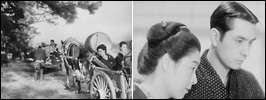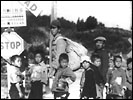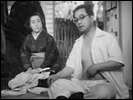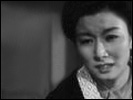 |
 |
|
Reviews by Tom Mes [TM], Nicholas Rucka [NR], Jasper Sharp [JS]
Notes of an Itinerant Performer
Children of the Beehive
Mr. Shosuke Ohara
Yotsuya Ghost Story
Ginza Sanshiro
Golden Demon
Twenty-Four Eyes
A Town of Love and Hope
|
 |
Notes of an Itinerant Performer
Original title: Uta-jo Oboegaki
Director: Hiroshi SHIMIZU
Cast: Yaeko MIZUTANI, Ken UEHARA, Hideo FUJINO, Kyoko ASAGIRI, Reikichi KAWAMURA
Running Time: 98 mins.
Year: 1941
 Wanderers, economic migrants and other social outcasts lie at the heart of many of Shimizu's dramas - those who have opted from what many call "a decent life" in favour of the romance of the road as well as those driven to this existence between urban centres through financial necessity. Uta, the itinerant performer of this film falls somewhere between the two stools. Her mother having died when she was six and never having known her father, she was forced into the travelling life when her grandmother died and now dances as part of a troupe of actors who roam from town to town giving street performances, part of an underclass whose existence barely registers on the social hierarchy. Wanderers, economic migrants and other social outcasts lie at the heart of many of Shimizu's dramas - those who have opted from what many call "a decent life" in favour of the romance of the road as well as those driven to this existence between urban centres through financial necessity. Uta, the itinerant performer of this film falls somewhere between the two stools. Her mother having died when she was six and never having known her father, she was forced into the travelling life when her grandmother died and now dances as part of a troupe of actors who roam from town to town giving street performances, part of an underclass whose existence barely registers on the social hierarchy.
An escape route from this marginal existence comes when she is afforded the opportunity to move into the household of tea merchant Hiramatsu where she is asked to teach the daughter of the family to dance. When the merchant later dies, leaving both the family and the family business in a state of financial disarray, her newly found position looks set to be thrown into jeopardy, but she is asked to stay by the older son Shôtaro and single-handedly sets the family business back on track again. But still will she ever be able to afforded the chance forget the lowly status of her original vocation?
Despite expectations raised by the title, and especially noticeable for a Shimizu film, the drama of Notes of An Itinerant Performer is predominantly staged within a single location. Still, with the long flowing takes and lengthy lateral movements of the camera, the characters hardly feel restrained by this setting. Like the director's The Ornamental Hairpin (Kanzashi) made in the same year, though Japan's war against the rest of Asia was building up to fever pitch, the conflict is never alluded, and the Meiji Period setting of 1901 is perhaps indicative of Shimizu's own desire to escape back into the nostalgic imaginary space of the past rather than tackling more contemporary subject matter. What remains is an evocative and infectious melodrama played out between the conflicting desires of duty to the collective and the desire to act as a free agent, and a masterfully made one at that.
[JS]
|
 |
Children of the Beehive
Original title: Hachi No Su No Kodomotachi
Director: Hiroshi SHIMIZU
Cast: Shusaku SHIMAMURA, Masako NATSUKI, Shoichi GOSHÔ, Shinichiro KUBOTA, Yutaka IWAMOTO
Running Time: 86 mins.
Year: 1948
 Shimizu's first feature outside of Shochiku, produced by his own independent film company Hachi No Su Eigabu (Beehive Films), Children of the Beehive focuses on the plight of ten war orphans hailing from different cities across Japan. With nowhere to go, they scavenge around train stations, scratching out an existence by means of black market work for a one-legged tramp whilst avoiding being picked up by the police for vagrancy. Soon however, they find a more inspiring role model in the figure of a nameless soldier just repatriated after the war. An orphan himself, the soldier also has no home to return to, and so sets out across the country with the kids in tow in search of work before settling on the goal of leading them to the orphanage where he himself grew up. Shimizu's first feature outside of Shochiku, produced by his own independent film company Hachi No Su Eigabu (Beehive Films), Children of the Beehive focuses on the plight of ten war orphans hailing from different cities across Japan. With nowhere to go, they scavenge around train stations, scratching out an existence by means of black market work for a one-legged tramp whilst avoiding being picked up by the police for vagrancy. Soon however, they find a more inspiring role model in the figure of a nameless soldier just repatriated after the war. An orphan himself, the soldier also has no home to return to, and so sets out across the country with the kids in tow in search of work before settling on the goal of leading them to the orphanage where he himself grew up.
Children of the Beehive could so easily have been marred by a cloyingly sentimental approach, but in Shimizu's hands it remains admirably subtle and understated, allowing the genuine exuberance and tenacity of the children (all real-life war orphans taken in and raised by the director) to comes across. The episodic flow of events is fresh and breezy yet against all odds, optimistic, with the interplay between this selfless stopgap father figure and his raggedy wards especially touching as he harangues them for smoking and tries to teach them sums which he scratches in the earth, at the same time trying to keep them all from hunger.
The film benefits from a wonderful use of locations and wide open spaces as the motley band of itinerants drift unfettered across the shattered, après guerre countryside (including a chilling vision of a post-atomic Hiroshima) of a nation trying to pick itself up off its feet after its defeat. A long-forgotten early landmark in post-war cinema, Children of the Beehive is one of the country's most essential works. A lesser-known sequel followed in 1951, entitled Those Later Children of the Beehive (Sono Ato No Hachi No Su No Kodomo).
[JS]
|
 |
Mr. Shosuke Ohara
Original title: Ohara Shosuke-san
Director: Hiroshi SHIMIZU
Cast: Denjiro OKOCHI, Akiko KAZAMI, Reiko MIYAGAWA
Running Time: 91 mins.
Year: 1949
 Saheita (Okochi), the final heir of a once rich and respectable family, can't refuse the many villagers that come to him for favours and money, even though he is on the brink of bankruptcy. Around town he is better known by his nickname Mr. Shosuke Ohara, after the folkloric character who squandered his riches through his preference for loitering and drinking. Saheita (Okochi), the final heir of a once rich and respectable family, can't refuse the many villagers that come to him for favours and money, even though he is on the brink of bankruptcy. Around town he is better known by his nickname Mr. Shosuke Ohara, after the folkloric character who squandered his riches through his preference for loitering and drinking.
In addition to being a lively and successful comedy (the battle of noises between the ladies' sewing club and the chanting Buddhist monk, both of whom have been given room in Sahieta's house, is truly hilarious), Shimizu's second post-war film is an allegory for a country in the midst of change, and a plea for independent thought and determination.
[TM]
|
 |
Yotsuya Ghost Story, Parts I and II
Original title: Shinshaku Yotsuya Kaidan
Director: Keisuke KINOSHITA
Cast: Kinuyo TANAKA, Ken UEHARA, Haruko SUGIMURA, Osamu TAKIZAWA, Choko IIDA
Running Time: 85 mins. / 73 mins.
Year: 1949
Yotsuya Ghost Story Parts I and II is a quiet period piece that is less horrific or chilling than the title would lead one to believe. In fact, the story is more of a cautionary tail that can be chalked up to the two old adages: "Be careful what you wish for, you might get it" and "You don't know what you've got until it's gone." Kinoshita's take on the classic Yotsuya ghost story focuses primarily on what elements would lead a ronin to murder his loving wife so that he may marry a wealthy woman and assume her societal status. As per this classic story, things are definitely not as they appear and soon enough the ronin realizes he has made a grave mistake indeed.
The performances from two of Shochiku's biggest stars from back in the day, Ken Uehara and Kinuyo Tanaka, are of note as a kind of time capsule of acting trends and stylizations. What must have been regarded as both profound and maybe even subtle in their dramatic execution now seems so stylized and overly dramatic that watching it takes some getting used to. Still, there are great moments in the performances which should not be understated.
This being said, the true star of this film is Kinoshita himself with his analytical eye and firm directing hand, and his cinematographer Hiroyuki Kusuda whose lighting and camera work are still impressive. Worth seeing if you have the opportunity.
[NR]
|
 |
Ginza Sanshiro
Original title: Ginza No Mosa
Director: Kon ICHIKAWA
Cast: Susumu FUJITA, Takashi SHIMURA, Reikichi KAWAMURA
Running Time: 82 mins.
Year: 1950
Still best known worldwide for his colourful kabuki concoction An Actor's Revenge, Kon Ichikawa's filmography is a vast and rather eclectic beast. The intrinsically postwar Ginza Sanshiro is reminiscent of Akira Kurosawa's Drunken Angel, made two years earlier. Both films portray the slow emergence of the country from the wartime rubble as seen through the eyes of a gallant neighbourhood physician. Both films see the doctor doing battle (mentally in Kurosawa's case, physically in Ichikawa's) with yakuza thugs, and both films star (co-star here) the great Takashi Shimura.
Where the two films differ vastly is in tone. Kurosawa's was a deeply allegorical and moody piece, containing more rage than hope. Ichikawa chooses a lighter, comical touch, and while his film is not devoid of darker moments, it is on the whole a rather optimistic affair.
Fujita plays the stocky single doctor, the would-be suitor to the daughter of his restaurateur neighbour if it weren't for the fact that he still carries a torch for his old love, a woman he lost touch with in Manchuria before the war. Mere moments after he finally concedes and agrees to marry the girl next door, he finds his old flame working in a yakuza-run nightclub. With the help of his non-conformist friend and colleague (Shimura) he succeeds in getting her out of their grasp. When he single-handedly defeats a group of six hoods, he gains national fame as "The Sanshiro of Ginza", but his problems have only just started. In addition to the gang menace, he now also needs to choose between two women.
A swift-paced and thoroughly enjoyable morality piece.
[TM]
|
 |
Golden Demon
Original title: Konjiki Yasha
Director: Koji SHIMA
Cast: Jun NEGAMI, Fujiko YAMAMOTO, Eiji FUNAKOSHI, Mitsuko MITO, Kinzo SHIN, Kumeko URABE
Running Time: 91 mins.
Year: 1953
 Koji Shima's 1953 film The Golden Demon (not to be confused with the 1912 production), hasn't aged so well with its stylized acting and over emphasis on melodrama and clunky symbolism. The film tells of poor university student Kanichi who has long planned to marry his childhood sweetheart, Omiya. When rich suitor, Tomiyama, goes behind Kanichi's back and arranges with Omiya's avaricious parents to marry her, Kanichi becomes convinced that his social status is to blame for his loss. Kanichi swears off women and dedicates years to earning money. With this passage of time, Tomiyama's marriage to Omiya proves dysfunctional-- bordering on the sadistic-- and she truly rues the error of her ways and longs for her old days with Kanichi. Kanichi, however, is possessed by greed, and has no desire to forgive Omiya. What is Omiya to do in this situation? Can Kanichi be reformed? Koji Shima's 1953 film The Golden Demon (not to be confused with the 1912 production), hasn't aged so well with its stylized acting and over emphasis on melodrama and clunky symbolism. The film tells of poor university student Kanichi who has long planned to marry his childhood sweetheart, Omiya. When rich suitor, Tomiyama, goes behind Kanichi's back and arranges with Omiya's avaricious parents to marry her, Kanichi becomes convinced that his social status is to blame for his loss. Kanichi swears off women and dedicates years to earning money. With this passage of time, Tomiyama's marriage to Omiya proves dysfunctional-- bordering on the sadistic-- and she truly rues the error of her ways and longs for her old days with Kanichi. Kanichi, however, is possessed by greed, and has no desire to forgive Omiya. What is Omiya to do in this situation? Can Kanichi be reformed?
Beautifully shot in color and realized in carefully blocked and framed shots, the film is undeniably gorgeous. Shima's ability to delicately place poignant inserts in the film is by far the strongest aspect of The Golden Demon: scenes of standard character drama become enriched with careful detailing. Unfortunately, the movie has a hard time making up for heavy, obvious writing and sappy melodrama, and never really takes off. With its careful attention to detail, perhaps the film would be best viewed as a well realized turn-of-the-century drama. The film however, is ultimately more Douglas Sirk melodrama than Akira Kurosawa period piece. With that in mind, those who like melodrama should appreciate the film.
[NR]
|
 |
Twenty-Four Eyes
Original title: Niju-shi No Hitomi
Director: Keisuke KINOSHITA
Cast: Hideko TAKAMINE, Yumeji TSUKIOKA, Takahiro TAMURA, Toshiko KOBAYASHI, Chishu RYU
Running Time: 154 mins.
Year: 1954
Kinoshita's epic saga of a teacher and her close relationship with the twelve pupils of the small local school where she works (the twenty-four eyes of the title) is a defining product of the Golden Age of Japanese Cinema of the 50s. Set in a small village on Shodoshima, the largest of the islands in the Japanese Inland Sea that divides three of Japan's four main islands, the story begins in 1928 when the arrival of the young Miss Oishi (Shochiku starlet, Takamine who had previously teamed up with Kinoshita in the comedy Carmen Comes Home) on bicycle and dressed in a suit sets the tongues of the conservative locals wagging ("How awfully modern!").
Initially referred to by the nickname, Miss Pebble, because of the Chinese characters that make up her name ("Big Stone"), Miss Oishii soon earns the trust of her students, acting as their moral and spiritual guardian throughout war, pregnancy, bereavement and national defeat up until the close of the film twenty years later.
A gloriously old-fashioned tearjerker, which was needlessly remade in 1987 by Yoshitaka Asama, it occasionally dips too deeply into its reserves of sentimentality. But the beautiful, picture-postcard compositions of the natural settings and the warm, incident dense plot combine to paint a vivid portrait of how this impoverished but close community of farmers and fisherman is affected by events in the wider world outside it. Some touching comic moments include an amusing scene where Chishû Ryû, acting in the role of stand-in teacher when Takamine injures herself, attempts to rouse the young students with a round of traditional songs, but other plot threads such as a teacher being arrested by the military police as a communist after printing an anti-war pamphlet for, and one girl, Matsue, forced to leave her education to work in a noodle store after the death of her mother point to the seriousness of Kinoshita's classic drama.
Though the Hong Kong DVD release from Panorama represents another case of atrocious subtitling from the company, interested parties are still advised to check it out - you could be waiting a long while holding out for a better version to come along.
[JS]
|
 |
A Town of Love and Hope
Original title: Ai To Kibo No Machi
Alternative title: A Street of Love and Hope
Director: Nagisa OSHIMA
Cast: Hiroshi FUJIKAWA, Yuki TOMINAGA, Yuko MOCHIZUKI, Fumio WATANABE, Michiko ITO
Running Time: 62 mins.
Year: 1959
A teenager from an impoverished background, it is up to Masao to bring in an income when his mother falls sick and is unable to ply her trade as a shoeshine. He does so by falling back on the ruse of selling pigeons, bringing him into contact with the other side of the social divide when Kyoko, the daughter of the owner of an electrical appliance factory buys one as a gift for her brother. The pigeon consequently flies back home to Masao, but nonetheless, Kyoko feels a sense of shame that this boy has been reduced to the level of selling his pets.
Masao's mother wants her son to go on and graduate from high school to offer him a better opportunity of escaping from this cycle of poverty, but Masao is more concerned with the immediate problem of putting food on the table to feed his mother and his younger sister Yasue. At the bequest of Kyoko, Masao's teacher Miss Akiyama approaches Kyoko's father to ask him to employ Masao.
In order to fight back against the box office doldrums brought about by the rising popularity of television, in the late 50s Shochiku president Shirô Kido offered several of its rising employees the chance to make their directorial debuts before the age of 30. The first to have a film released was Nagisa Ôshima, and the result was this raw and historically pivotal film.
The change in focus to social rather than domestic dramas and the use of real location shooting was a radical departure from the so-called "Ôfuna flavour" of Shochiku's output, named after the studios where they were shot. The tackling of such issues as the unfair post-war distribution of wealth and inequality of opportunities to certain sectors of the population head on through its shanty-dwelling teenage protagonist were also innovations that would ensure that Japanese film would never be the same again. Despite the short running time, with a softer centre than his successive work, Ôshima's debut achieves a fine balance of social critique and poignant drama, paving the way for more radical filmmaking practices over the course of the next decade.
[JS] |